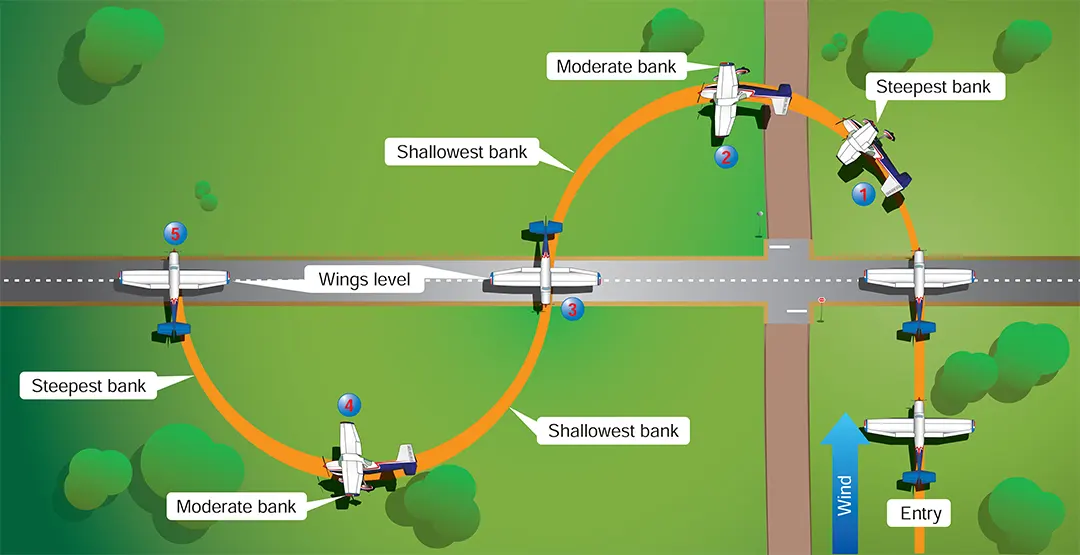An S-turn is a ground reference maneuver in which the airplane’s ground track resembles two opposite but equal half-circles on each side of a selected ground-based straight-line reference. This ground reference maneuver presents a practical application for the correction of wind during a turn. The objectives of S-turns across a road (or line) are as follows:
- Maintaining a specific relationship between the airplane and the ground.
- Dividing attention between the flightpath, ground-based references, manipulating the flight controls, and scanning for outside hazards and instrument indications.
- Adjusting the bank angle during turns to correct for groundspeed changes in order to maintain a constant-radius turn—steeper bank angles for higher groundspeeds, shallow bank angles for slower groundspeeds.
- Rolling out from a turn with the required wind correction angle to compensate for any drift cause by the wind.
- Establishing and correcting the wind correction angle in order to maintain the track over the ground.
- Developing the ability to compensate for drift in quickly-changing orientations.
- Arriving at specific points on required headings.
https://aircraftsystemstech.com/humix/video/UIWeIoRjlIf
With the airplane in the downwind position, the maneuver consists of crossing a straight-line ground reference at a 90° angle and immediately beginning a 180° constant-radius turn. The pilot will then adjust the roll rate and bank angle for drift effects and changes in groundspeed, and re-cross the straight-line ground reference in the opposite direction just as the first 180° constant-radius turn is completed. The pilot will then immediately begin a second 180° constant-radius turn in the opposite direction, adjusting the roll rate and bank angle for drift effects and changes in groundspeed, again re-crossing the straight-line ground reference as the second 180° constant-radius turn is completed. If the straight-line ground reference is of sufficient length, the pilot may complete as many as can be safely accomplished.

In the same manner as the rectangular course, it is standard practice to enter ground-based maneuvers downwind where groundspeed is greatest. As such, the roll into the turn should be rapid, but not aggressive, and the angle of bank should be steepest when initiating the turn. As the turn progresses, the bank angle and the rate of rollout should be decreased as the groundspeed decreases to ensure that the turn’s radius is constant. During the first turn, when the airplane is at the 90° point, it will be directly crosswind. In addition to the rate of rollout and bank angle, the pilot should control the wind correction angle throughout the turn.
Controlling the wind correction angle during a turn can be complex to understand. The concept may be understood by comprehending the difference between the number of degrees that the airplane has turned over the ground versus the number of degrees that the airplane has turned in the air. As an example, assume the airplane is exactly crosswind, meaning directly at a point that is 90° to the straight-lined ground reference. In this example, if the wind requires a 10° wind correction angle (for this example, this is a left turn with the crosswind from the left), the airplane would be at a heading that is 10° ahead when directly over the 90° ground reference point. In other words, the first 90° track over the ground would result in a heading change of 100° and the last 90° track over the ground would result in 80° of heading change.
As the turn progresses from a downwind position to an upwind position, the pilot should gradually decrease the bank angle with coordinated aileron and rudder pressure. The pilot should reference the airplane’s nose, wingtips, and the ground references and adjust the rollout timing so that the wings become level just as the airplane crosses the straight-line ground reference at the proper heading, altitude, and airspeed. As the airplane re-crosses the straight-lined ground reference, the opposite turn begins—there should be no delay in rolling out from one turn and rolling into the next turn. Because the airplane is now upwind, the roll in should be smooth and gentle and the initial bank angle should be shallow. As the turn progresses, the wind changes from upwind, to crosswind, to downwind. In a similar manner described above, the pilot should adjust the bank angle to correct for changes in groundspeed. As the groundspeed increases, the pilot should increase the bank angle to maintain a constant-radius turn over the ground. At the 90° crosswind position, the airplane should also have the correct wind correction angle. As the airplane turns downwind and the groundspeed increases, the bank angle should be increased so that the rate of turn maintains a constant-radius turn.
The following are the most common errors made while performing S-turns across a road:
- Failure to adequately clear surrounding area for safety hazards, initially and throughout the maneuver.
- Failure to establish a constant, level altitude prior to entering the maneuver.
- Failure to maintain altitude during the maneuver.
- Failure to properly assess wind direction.
- Failure to properly execute constant-radius turns.
- Failure to manipulate the flight controls in a smooth and continuous manner when transitioning into turns.
- Failure to establish the appropriate wind correction angle.
- Failure to apply coordinated aileron and rudder pressure, resulting in slips or skids.
